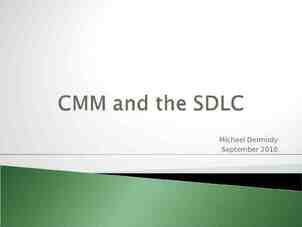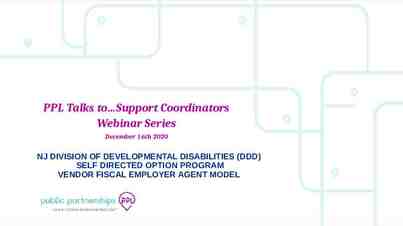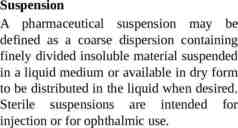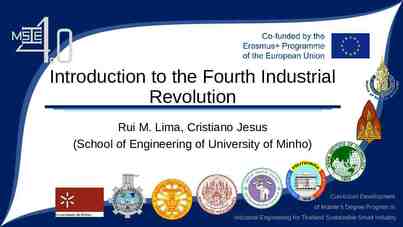Church Planting Discernment Gathering Pennsylvania
57 Slides2.55 MB

Church Planting Discernment Gathering Pennsylvania Southeast Conference United Church of Christ Rev. William Worley, Conference Minister October 28, 2017 UCC Valley Forge 10:00am – 2:00pm

12 Reasons to Plant a Church It’s Biblical Spirit of Prophecy supports it Most effective form of evangelism Churches have life cycles Saves the Denomination Stimulates growth in established churches

Leadership Opportunities Reaches Present Generation Mobility of society Ethnic Populations Finances Someone planted your church! Which of these 12 speak to where PSEC is now?

Studies Show that if a denomination wishes to reach more people the number of new churches it begins must equal at least 3% of the denominations existing churches. Ed Stetzer, Planting Missional Churches p. 5 In order to balance church closure, 6 Churches per year should be our minimum goal.

3 types of church plant starts: 1.Cold 2.Warm 3.Hot What is the difference?

COLD PLANT Acts 8:4-7 PHILIP

WARM PLANT Acts 13:1-3 PAUL The most effective church planting occurs when a sponsor/mother church is actively involved! Each year the attendance of a new church is 2x higher than those without the participation of a sponsoring mother church. Ed Stetzer, Planting Missional Churches p.79-80

Role of Mother Church Encouragement Coaching Financial Assistance Core Team Facilities Accountability Love/Unity Prayer Why should you never plant without a mother church or sponsoring church?

HOT PLANT “Multiplication by Division” When a congregation intentionally (or not) decides to splint that it might maintain a more manageable size.

8 Models of Church Planting 1. Independent Pioneer Model 2. Mother-Daughter Model 3. Colonizing Model 4. Multi-Congregational Model 5. Satellite Model 6. Missionary Model 7. Denominational Model 8. Cellular Model

1) CREATE THE CLIMATE Already established churches DO NOT naturally move toward church planting True or False?

Churches DO NOT naturally move toward church planting LOSS of Fellowship LOSS of Finances LOSS of Ministry Leaders LACK of Kingdom Focus LACK of Health

Despite obstacles, most churches can be LED toward birthing daughter congregations.

How can you help prepare your church to plant?

Nehemiah 2:17-20 1. 2. 3. 4. Sound the Alarm Cast God’s Vision Show the Benefits Answer objections Can you present the above to your church? What would you say, how would you say it, and when?

“The single most effective evangelism methodology under heaven is planting new churches.” Peter Wagner, Church Planting for a greater Harvest p. 11

Nehemiah 2:18 “Then I told them of the hand of my God which was good upon me; as also the king's words that he had spoken unto me. And they said, Let us rise up and build. So they strengthened their hands for this good work.

SINGLE MOST IMPORTANT DECISION! “Everything rises and falls on leadership.” John Maxwell

Luke 6:12 And it came to pass in those days, that he went out into a mountain to pray, and continued all night in prayer to God. 13 And when it was day, he called unto him his disciples: and of them he chose twelve, whom also he named apostles;

Matthew 9:37 Then saith he unto his disciples, The harvest truly is plenteous, but the labourers are few; 38 Pray ye therefore the Lord of the harvest, that he will send forth labourers into his harvest.

The most successful church planters share 13 behavioral characteristics Visioning capacity Intrinsically motivated Creates ownership of ministry One who relates to the unchurched Spousal/Family Cooperation Effectively builds relationships

Committed to Church Growth Responsiveness to the community One who uses the giftedness of others Flexible and adaptable Builds group cohesiveness Demonstrates resilience Exercises faith Ed Stetzer, Planting Missional Churches p.82-83

In every group of three people there is always someone who is a little nuts. Look around you and if everyone else looks normal you might be a church planter!

Church Planting Funding The Large Donor Campaign Model (We call it: “The Shark Tank Model”) “Church plants seeks investment from big rollers. 5-digit gifts preferred. We meet our goal of 250,000, we’ll change the world.” This approach seeks an initial lump sum, and it’s often driven by pursuing large donors. It’s modeled on the business investment/venture capital view of the world. Advantage: If successful, you can parlay that “freeze-dried work” into something pretty big pretty fast (say, a crucial sound system for Sunday morning). Disadvantage: Can be tougher to pitch than you think. Investors like to invest in known quantities with proven results and tight accountability. And fixed amounts run out quickly if applied to ongoing costs. 100,000 sounds like a lot, but may not cover even two years of salary and health insurance, and then it’s gone. How it can affect the mission: Investors expect a return. What does this mean for your church plant? What is their stake in your approach or ministry method? Secondly, If the money is going to run out in two years, the rush is on to get 200 “tithing units” in the door. We want reach an unreached world, but 200 Christians might tithe, while non-Christians they probably don’t. Does that affect our Sunday morning choices?

Church Planting Funding The Bi-Vocational Model “No fundraising for our church plant! But because we need money, we’re starting a small business on the side and each of us is working bi-vocationally to pay for our ministry work.” The bi-vocational approach successfully avoids fundraising by trying to leverage market forces for individual employment and even business-as-mission. Advantage: Built-in community engagement for gospel relationships. Church leaders are a witness in their secular workplaces, and/or church based businesses (e.g. bakery, coffee shop, event space) may contribute to the local community and economy Disadvantage: Certain jobs are not well-suited to this, and planters may need the right career training or education to get the right ones. A full-time demanding job, a growing family, and a growing church can sometimes feel as if “bi-vocational” has grown into into 3 or 4 or 5 vocations! How it can affect the mission: Bosses expect a commitment. When choices are required in time and effort, does family, work, or the church plant sacrifice?

Church Planting Funding The Missionary Support Model (We call it: “The Campus Crusade Model”) The Bill Bright-founded organization is the largest mission agency in the world. In an era of falling church investment in evangelism, he pioneered the individual missionary support model, which seeks commitments from 50 to 100 individuals to give regular monthly amounts. Advantage: This “small-donor” model can raise a surprising amount of money over time, because the request is for an ongoing amount, not a one-time gift. The giving tends to be stable through economic and ministry downturns. Once established, a support-based salary can travel with you (good for apostolic ministry, multiple church plants) and is much easier to maintain then build the first time. A outside team’s ongoing commitment invests them in the church plant not only financially, but prayerfully. Disadvantage: Missionary style support take can 6-12 months of focused, full-time work to complete, much like starting up a small business. This makes it better for ongoing ministry. How it can affect the mission: May require about 5-10% of ongoing time to maintain, including a prayer letter reporting back to the team. Money is going to matter for mission. It can capture and focus the efforts of many into building the Church. The church planter’s challenge to discern how its use affects the mission.

Win Parent Churches Approval Write a Letter –Appreciation –Vision –Permission Make a board appointment –Personally communicate your God given vision *Remember if created the climate this will be much healthier *Remember you will also need Conference approval

Recruit Your Team Where to look for your core team? –Mother Church –Sister church –Conference –Spirit led contacts –Members living in target area Hint: majority of your team should reflect the age, gender, race and culture you are trying to reach! Acts 16:1-3—Timothy

Building a Core Group 1. Shared passion/vision. 2. Individuals who put mission first. 3. Individuals who are a magnet to others. 4. Individuals who match the demographic to be reached. Prioritize the above list

Team Meetings Start 6-9 months before Launch Date Meet every Sabbath afternoon Purpose –Prayer –Vision Casting –Discussion/Reporting Assigning Ministries(SHAPE) –Church Planter, Worship Leader, Assimilation Coordinator, Evangelism Networker, Children’s ministry coordinator.

Incubate 6-9 months as a core group of leaders. -Create Community (Get to know one another) -Prayer & Fasting -Study of Acts & ReKindling a Lost Passion by Russell Burrill -Establish core values -Develop Strategic Plan (including target demographic and evangelistic methods) -Ministry assignments -Practice worship

4). Choose your location Path of Growth (Cities) Homogenous New Developments! Rent do not buy! (5 years) –3x annual tithe saving Rent space you half fill –80% rule Ideas: Store fronts, Churches, Day Care

5). Funding Your Church Plant Core Team Mother church Business People Conference Harvest (Coins in the fish)

6. Attracting a Crowd Direct Mail –Multiple mail outs (10, 5, 1) –Mass letter identifying with needs of focus group Telemarketing –Tell Start (automatic call system) Personally/letter Invite former SDAs Small Groups –Core team Divides –Invites –Ministry

Broadcasting—T.V. Radio Public Service Announcements Evangelistic Series Movie Theater Slides Facebook, E-mail announcements Word of Mouth Creative Local Paper Advertisement –Crossroads is coming –Crossroads is coming with logo –Crossroads is coming with logo and time –Crossroads is coming with logo and time and that it is a great new church!

Hand out flyers around church Bumper Stickers Business Card Invitations –Challenge members give away 12 each month Door Hangers –Cheaper than mail outs 75% of people who are in the church today are there because a family member or friend invited them. 90% of people will say yes to attending church if they are invited by a friend.

7). Your First Service Start on time Friendly and Accepting Atmosphere – 3 minutes comfort – 10 minutes return – Gift Bag Visual Vibrant Worship Seeker Sensitive Biblical, Practical, Christ-centered Fellowship Meal Response Cards

8). Keeping Your Crowd Response Cards Sunday –Call all phone numbers “thank you” –Send out letters Tuesday –Mail invitational cards Thursday –Planter calls and invites each family Evangelism Coordinator oversees this

Assimilation New Members need 6-9 friends Identify their gifts At least one ministry Small Group Involvement Give Regularly Refers to church as “mine.” New Members Class Overseen by Assimilation Coordinator

Natural Church Development Most Important Research—Christian Swartz Healthy Churches Grow! 1.Empowering Leaders 2.Gift Oriented Ministries 3.Passionate Spirituality 4.Functional Structures 5.Inspiring Worships 6.Holistic Small Groups 7.Need Oriented Evangelism 8.Loving Relationships

10). Keeping Your Core Team Celebrate Often Continue Meeting Monthly Cast and Re-Cast Vision Expect desertions –“Escape Clause” Concept

11). Coaching Difficult for church planters! –If not willing to invest in leadership won’t make it! Meet regularly with Pastor-Coach Friend, Confidant, Advocate, Intercessor 5 Rs – Relate “How are you?” – Reflect “what can we celebrate?” – Refocus “What do you want to accomplish?” – Resources “what resources do you need?” – Reflect “what working, what is not working?”

Our Message!

#4 Step to Planting: Healthy Core Group

#5 Step to Plant: Incubation

Incubate 6-9 months as a core group of leaders. In-home meeting 1x a week Note: You wait to worship on Sabbath mornings UNTIL you have incubated!

#6 Step to Plant: COACH

Requirements: 1. Every Lay Planter is assigned a coach.

Equipping Lay Planters for Excellence in Ministry Definition of coach: --A full-time minister employed by the Conference.

Equipping Lay Planters for Excellence in Ministry Qualifications of a coach - Proven soul-winner - Excellent listener - Empowering (will not take over the plant). - Familiar with the techniques of coaching and self-discovery. - Willing to commit (this is voluntary!)

Requirements: 1. Personal Coaching Relationship. Lay Planter and Coach will meet on a monthly basis for a coaching appointment. Lunch or supper is recommended and will be reimbursed (up to 20.00) by the church planting department.

Content of Coaching Meeting: --Ask Questions Examples: “What successes/victories have you experienced recently?” “What can you celebrate?” “What challenges are you currently encountering that we can pray about?”

Content of Coaching Meeting: --Ask Questions --Listen --Encourage --Accountability --Resource --Prayer

Requirements: 2. Coach meets with church plant group on a monthly basis. --Only 1x quarter on Sabbath morning. Options include: board meeting, business meeting, social, youth outing, etc. --Coach conducts baptisms and ordinations. Purpose: A relationship is built with the coach. The coach can resource the lay planter more intelligently.

Requirements: 3. Coach holds a one week (two weekend) reaping evangelist meeting with the plant on an annual basis. -- The coach has a relationship with the group so they will be well prepared and supportive of the meeting. -- This provides an affordable evangelistic endeavor on a regular basis for the church.

Added benefits of a coach Coach encourages planter and plant to: -- move toward company and then church status. -- stay focused on the mission of the church through regular evangelistic endeavors. -- be realistic regarding facility needs and requests. -- keep a positive relationship with the Conference.

Contact Information: Tom Evans [email protected] 817-307-4026






